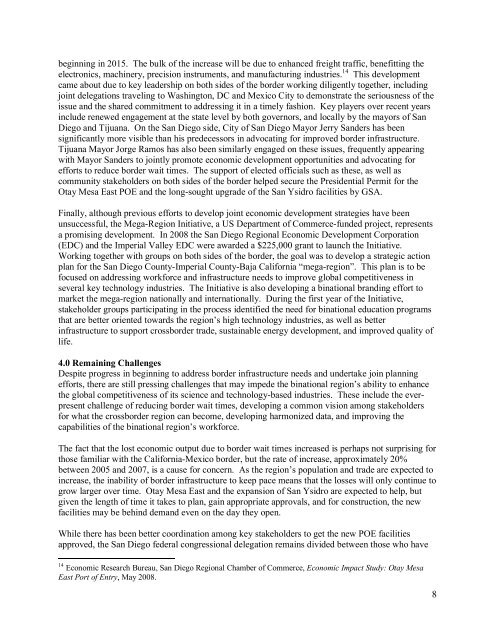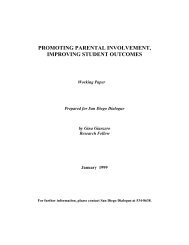Corridors and Clusters - San Diego Dialogue
Corridors and Clusters - San Diego Dialogue
Corridors and Clusters - San Diego Dialogue
Create successful ePaper yourself
Turn your PDF publications into a flip-book with our unique Google optimized e-Paper software.
eginning in 2015. The bulk of the increase will be due to enhanced freight traffic, benefitting the<br />
electronics, machinery, precision instruments, <strong>and</strong> manufacturing industries. 14 This development<br />
came about due to key leadership on both sides of the border working diligently together, including<br />
joint delegations traveling to Washington, DC <strong>and</strong> Mexico City to demonstrate the seriousness of the<br />
issue <strong>and</strong> the shared commitment to addressing it in a timely fashion. Key players over recent years<br />
include renewed engagement at the state level by both governors, <strong>and</strong> locally by the mayors of <strong>San</strong><br />
<strong>Diego</strong> <strong>and</strong> Tijuana. On the <strong>San</strong> <strong>Diego</strong> side, City of <strong>San</strong> <strong>Diego</strong> Mayor Jerry S<strong>and</strong>ers has been<br />
significantly more visible than his predecessors in advocating for improved border infrastructure.<br />
Tijuana Mayor Jorge Ramos has also been similarly engaged on these issues, frequently appearing<br />
with Mayor S<strong>and</strong>ers to jointly promote economic development opportunities <strong>and</strong> advocating for<br />
efforts to reduce border wait times. The support of elected officials such as these, as well as<br />
community stakeholders on both sides of the border helped secure the Presidential Permit for the<br />
Otay Mesa East POE <strong>and</strong> the longsought upgrade of the <strong>San</strong> Ysidro facilities by GSA.<br />
Finally, although previous efforts to develop joint economic development strategies have been<br />
unsuccessful, the MegaRegion Initiative, a US Department of Commercefunded project, represents<br />
a promising development. In 2008 the <strong>San</strong> <strong>Diego</strong> Regional Economic Development Corporation<br />
(EDC) <strong>and</strong> the Imperial Valley EDC were awarded a $225,000 grant to launch the Initiative.<br />
Working together with groups on both sides of the border, the goal was to develop a strategic action<br />
plan for the <strong>San</strong> <strong>Diego</strong> CountyImperial CountyBaja California “megaregion”. This plan is to be<br />
focused on addressing workforce <strong>and</strong> infrastructure needs to improve global competitiveness in<br />
several key technology industries. The Initiative is also developing a binational br<strong>and</strong>ing effort to<br />
market the megaregion nationally <strong>and</strong> internationally. During the first year of the Initiative,<br />
stakeholder groups participating in the process identified the need for binational education programs<br />
that are better oriented towards the region’s high technology industries, as well as better<br />
infrastructure to support crossborder trade, sustainable energy development, <strong>and</strong> improved quality of<br />
life.<br />
4.0 Remaining Challenges<br />
Despite progress in beginning to address border infrastructure needs <strong>and</strong> undertake join planning<br />
efforts, there are still pressing challenges that may impede the binational region’s ability to enhance<br />
the global competitiveness of its science <strong>and</strong> technologybased industries. These include the everpresent<br />
challenge of reducing border wait times, developing a common vision among stakeholders<br />
for what the crossborder region can become, developing harmonized data, <strong>and</strong> improving the<br />
capabilities of the binational region’s workforce.<br />
The fact that the lost economic output due to border wait times increased is perhaps not surprising for<br />
those familiar with the CaliforniaMexico border, but the rate of increase, approximately 20%<br />
between 2005 <strong>and</strong> 2007, is a cause for concern. As the region’s population <strong>and</strong> trade are expected to<br />
increase, the inability of border infrastructure to keep pace means that the losses will only continue to<br />
grow larger over time. Otay Mesa East <strong>and</strong> the expansion of <strong>San</strong> Ysidro are expected to help, but<br />
given the length of time it takes to plan, gain appropriate approvals, <strong>and</strong> for construction, the new<br />
facilities may be behind dem<strong>and</strong> even on the day they open.<br />
While there has been better coordination among key stakeholders to get the new POE facilities<br />
approved, the <strong>San</strong> <strong>Diego</strong> federal congressional delegation remains divided between those who have<br />
14<br />
Economic Research Bureau, <strong>San</strong> <strong>Diego</strong> Regional Chamber of Commerce, Economic Impact Study: Otay Mesa<br />
East Port of Entry, May 2008.<br />
8






